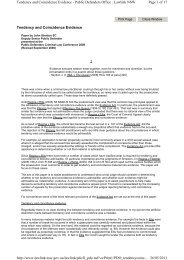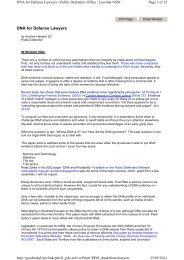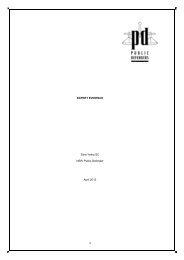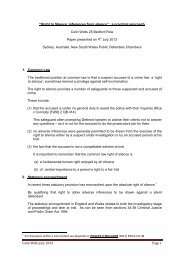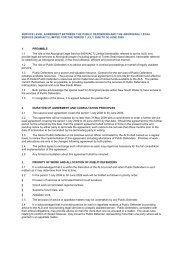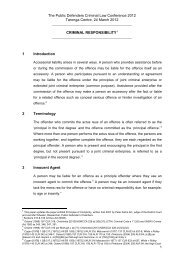DNA for NJC - The Public Defenders
DNA for NJC - The Public Defenders
DNA for NJC - The Public Defenders
Create successful ePaper yourself
Turn your PDF publications into a flip-book with our unique Google optimized e-Paper software.
including admissibility and fairness, issues when circumstantial genetic evidence of identity<br />
is sought to be adduced in a prosecution case. 65<br />
On one view a ‘not excluded’ finding has no relevant probative value. On the other hand a<br />
case can be proved by amassing small threads of evidence, none of which need to be<br />
proved to any standard; threads which may only assume relevance when combined. 66<br />
Should a jury or judge not be told that, as with the case of Aytugrul, that the profile found<br />
could occur in 1 in 50 people in the community? My preference is to say “no,” such a figure<br />
really has no relevance or has the potential to induce unfair and prejudicial reasoning<br />
process. 67 I suspect the appeal courts will say as they did in the UK LT<strong>DNA</strong> case of Reed<br />
that as long as it is accompanied by careful direction such evidence is still both relevant and<br />
admissible.<br />
Conclusion<br />
<strong>DNA</strong> evidence can assist the prosecution establish the identity of an offender. A profile<br />
match even if supported by impressive statistics as to its rarity is not regarded by courts<br />
proof of identity. <strong>The</strong> sensitivity of <strong>DNA</strong> testing brings with it consequent dangers from<br />
contamination, including undiscovered secondary transfer of <strong>DNA</strong> and overestimates of the<br />
efficacy and reliability of the available technology. <strong>The</strong> potential probative <strong>for</strong>ce of statistics,<br />
given in support of a <strong>DNA</strong> profile match, means great care must always be taken in the<br />
presentation of the <strong>DNA</strong> evidence and how a jury is directed to use such evidence.<br />
If there is a real and substantial risk that the way in which evidence is expressed can result<br />
in unfairness then fair and consistent ways of explaining the true import of the evidence and<br />
giving a jury a correct understanding about the relative rarity of the profile must be found.<br />
Serious consideration also needs to be given to questions of admissibility of some <strong>DNA</strong><br />
evidence. If admitted the qualifications and assumptions behind it must be carefully<br />
explained and accompanied by appropriate directions or warnings.<br />
That said; most <strong>DNA</strong> results on the Profiler Plus system from unmixed sources are clear and<br />
unambiguous and backed by likelihood ratios in the billions. While it is theoretically possible<br />
another unrelated person might have the same profile this is so unlikely that the result can<br />
be expressed with a degree of scientific certainty far in excess of other conclusions of fact<br />
regularly accepted by the courts.<br />
65 Here’s another suggestion <strong>for</strong> a future paper.<br />
66 <strong>The</strong> Queen v Hillier (2007) 233 ALR 634.<br />
67 See Report of the Australian Law Re<strong>for</strong>m Commission Evidence Report 2 vol 1 at [957].<br />
18



